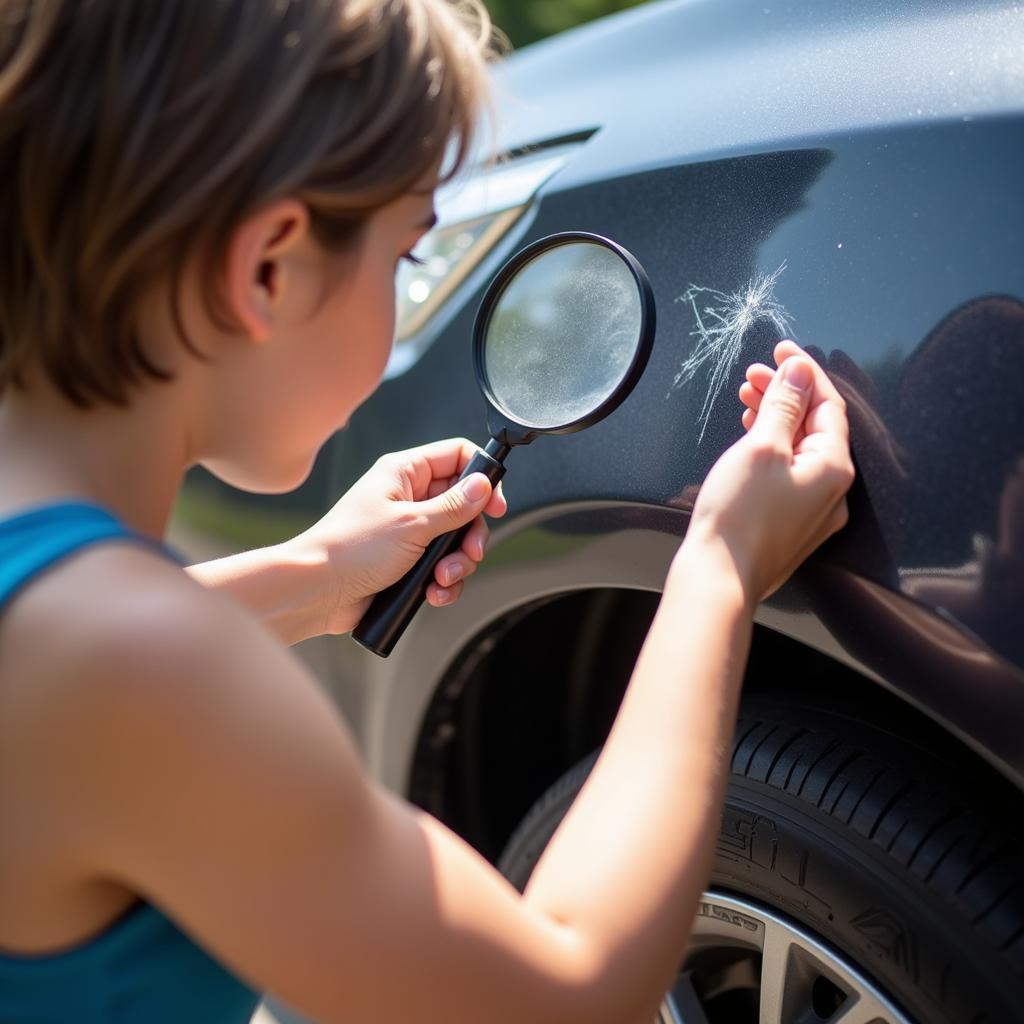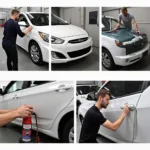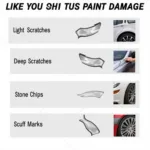Fixing car paint scratches at home can save you time and money. This guide will cover everything you need to know, from assessing the damage to achieving a professional-looking finish. Whether it’s a minor scuff or a deeper scratch, we’ll explore the best methods for home repair car paint scratches.
Assessing the Damage: Knowing Your Enemy
Before diving into the repair process, it’s crucial to assess the severity of the scratches. Is it a clear coat scratch, a primer scratch, or has it reached the base coat? This determines the approach and materials needed for your home repair car paint scratches project. Light scratches may only require a simple polishing compound, while deeper scratches might necessitate touch-up paint and clear coat.
After the first wash, inspect the car’s finish under direct sunlight. This will highlight any imperfections you may have missed initially. Accurately identifying the depth of the scratch will ensure you choose the right repair method.
Gathering Your Arsenal: Essential Tools and Materials
Having the right tools and materials is essential for a successful home repair car paint scratches project. Here’s a checklist:
- Car wash soap and microfiber towels: Thoroughly cleaning the area is crucial before any repair work begins.
- Rubbing compound and polishing compound: For minor scratches and swirl marks.
- Touch-up paint (matched to your car’s color): For deeper scratches that have penetrated the base coat.
- Clear coat: To seal and protect the repaired area.
- Sandpaper (various grits): For smoothing out deeper scratches.
- Masking tape and paper: To protect surrounding areas during the repair process.
- Applicators (foam pads, brushes, etc.): For applying the compounds and paint.
Remember, the quality of your materials directly impacts the final result. Invest in reputable brands for best results.
Repairing Minor Scratches: The Polishing Approach
If the scratch is minor and only affects the clear coat, you can likely remove it with polishing compound. First, wash and dry the area thoroughly. Then, apply a small amount of rubbing compound to a foam applicator pad and rub it gently over the scratch using circular motions. Follow this with polishing compound for a smooth and shiny finish. You can learn more about tackling minor imperfections at repair car paint scratches at home. This process is often sufficient for removing swirl marks and light scratches.
Tackling Deeper Scratches: The Touch-Up Method
For deeper scratches that have reached the primer or base coat, you’ll need touch-up paint. Clean the area thoroughly and use masking tape to protect surrounding paint. Apply the touch-up paint carefully, allowing it to dry completely. You might find our guide on car paint ding repair helpful for this step. Once dry, apply clear coat to seal and protect the repair. For more stubborn issues, consider researching how to repair a stone chip on car paint. Sanding may be necessary to level the surface before applying clear coat, especially with chip car paint repair. Learning how to repair deep scratch in car paint will give you a comprehensive understanding of this more involved process.
Preventing Future Scratches: A Proactive Approach
Preventing scratches is easier than repairing them. Regularly washing and waxing your car creates a protective barrier. Be mindful of where you park and avoid tight spaces. Using a car cover can also help protect your car’s finish.
Conclusion: Restoring Your Car’s Shine
Home repair car paint scratches can be a rewarding experience, saving you money and giving you a sense of accomplishment. By understanding the different types of scratches and using the right techniques and materials, you can restore your car’s finish to its former glory.
FAQ
- Can I use household cleaners to clean my car before repairing scratches? No, household cleaners can strip the wax and damage the clear coat. Use dedicated car wash soap.
- What if the touch-up paint doesn’t perfectly match my car’s color? Slight variations are normal. Blending techniques can help minimize the difference.
- How long should I wait before applying clear coat after touch-up paint? Follow the manufacturer’s instructions on the touch-up paint for drying times.
- Can I repair scratches on plastic bumpers? Yes, but use products specifically designed for plastic.
- Is it necessary to sand the area after applying touch-up paint? Only if the paint is raised above the surrounding surface.
- What type of sandpaper should I use for wet sanding? Start with a finer grit (2000 or higher) and gradually move to coarser grits if needed.
- How can I prevent swirl marks when polishing? Use a high-quality polishing compound and a clean microfiber cloth. Apply even pressure and work in small sections.
Situations and Questions
-
Scenario: Your car gets keyed in a parking lot, leaving a deep scratch.
-
Question: Can this be repaired at home, or is professional help required?
-
Scenario: You notice numerous small swirl marks after washing your car.
-
Question: What’s the best way to remove these without damaging the clear coat?
-
Scenario: A rock chips your car’s paint on the highway.
-
Question: How can I prevent rust from forming in the chipped area?
Further Reading and Resources
- For more information on maintaining your car’s exterior, explore our other articles on car detailing and paint protection.
- Check out our detailed guides on specific car repair topics, such as dent removal and windshield repair.
Need help with your car repair? Contact us via WhatsApp: +1(641)206-8880, Email: [email protected]. We have a 24/7 customer support team ready to assist you.



